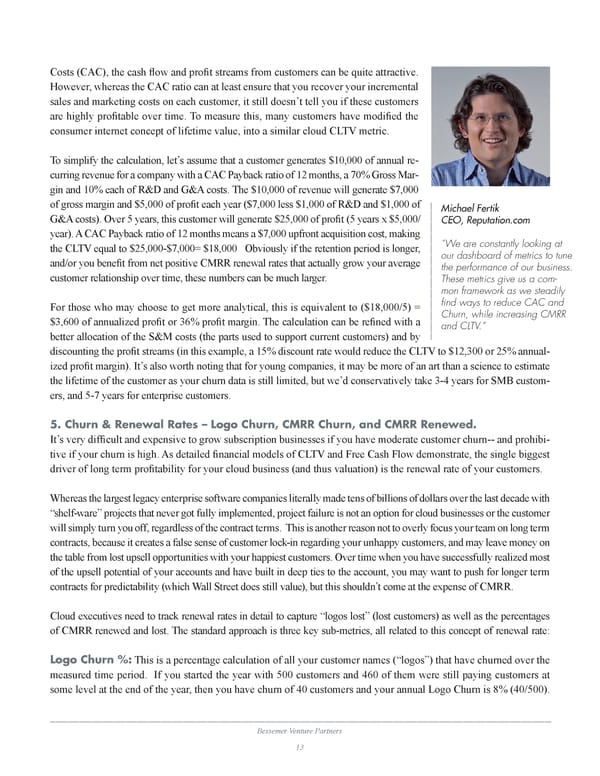Costs (CAC), the cash flow and profit streams from customers can be quite attractive. However, whereas the CAC ratio can at least ensure that you recover your incremental sales and marketing costs on each customer, it still doesn’t tell you if these customers are highly profitable over time. To measure this, many customers have modified the consumer internet concept of lifetime value, into a similar cloud CLTV metric. To simplify the calculation, let’s assume that a customer generates $10,000 of annual re- curring revenue for a company with a CAC Payback ratio of 12 months, a 70% Gross Mar- gin and 10% each of R&D and G&A costs. The $10,000 of revenue will generate $7,000 of gross margin and $5,000 of profit each year ($7,000 less $1,000 of R&D and $1,000 of Michael Fertik G&A costs). Over 5 years, this customer will generate $25,000 of profit (5 years x $5,000/ CEO, Reputation.com year). A CAC Payback ratio of 12 months means a $7,000 upfront acquisition cost, making the CLTV equal to $25,000-$7,000= $18,000 Obviously if the retention period is longer, “We are constantly looking at and/or you benefit from net positive CMRR renewal rates that actually grow your average our dashboard of metrics to tune the performance of our business. customer relationship over time, these numbers can be much larger. These metrics give us a com- mon framework as we steadily For those who may choose to get more analytical, this is equivalent to ($18,000/5) = find ways to reduce CAC and $3,600 of annualized profit or 36% profit margin. The calculation can be refined with a Churn, while increasing CMRR and CLTV.” better allocation of the S&M costs (the parts used to support current customers) and by discounting the profit streams (in this example, a 15% discount rate would reduce the CLTV to $12,300 or 25% annual- ized profit margin). It’s also worth noting that for young companies, it may be more of an art than a science to estimate the lifetime of the customer as your churn data is still limited, but we’d conservatively take 3-4 years for SMB custom- ers, and 5-7 years for enterprise customers. 5. Churn & Renewal Rates – Logo Churn, CMRR Churn, and CMRR Renewed. It’s very difficult and expensive to grow subscription businesses if you have moderate customer churn-- and prohibi- tive if your churn is high. As detailed financial models of CLTV and Free Cash Flow demonstrate, the single biggest driver of long term profitability for your cloud business (and thus valuation) is the renewal rate of your customers. Whereas the largest legacy enterprise software companies literally made tens of billions of dollars over the last decade with “shelf-ware” projects that never got fully implemented, project failure is not an option for cloud businesses or the customer will simply turn you off, regardless of the contract terms. This is another reason not to overly focus your team on long term contracts, because it creates a false sense of customer lock-in regarding your unhappy customers, and may leave money on the table from lost upsell opportunities with your happiest customers. Over time when you have successfully realized most of the upsell potential of your accounts and have built in deep ties to the account, you may want to push for longer term contracts for predictability (which Wall Street does still value), but this shouldn’t come at the expense of CMRR. Cloud executives need to track renewal rates in detail to capture “logos lost” (lost customers) as well as the percentages of CMRR renewed and lost. The standard approach is three key sub-metrics, all related to this concept of renewal rate: Logo Churn %: This is a percentage calculation of all your customer names (“logos”) that have churned over the measured time period. If you started the year with 500 customers and 460 of them were still paying customers at some level at the end of the year, then you have churn of 40 customers and your annual Logo Churn is 8% (40/500). Bessemer Venture Partners 13
 Bessemer’s Top 10 Laws of Cloud Computing Page 12 Page 14
Bessemer’s Top 10 Laws of Cloud Computing Page 12 Page 14